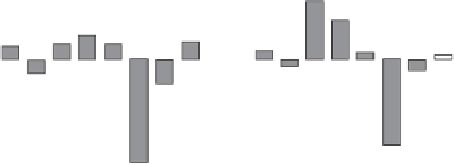Agriculture Reference
In-Depth Information
(b) Ponderosa pine
(a) Mixed conifer
2
1
0
-1
-2
-5 -4 -3 -2 -1
0
1
2
-5 -4 -3 -2 -1
0
12
Fire year
Fire year
Fig. 2.8
Presentation known as the superposed epoch analysis of fire activity and Palmer
Drought Severity Index (PDSI); bars above zero indicate a wet year and below zero a drought
year, and the horizontal solid, dashed and dotted lines indicate 95%, 99% and 99.9% confidence
levels, for (a) mixed conifer forests and (b) ponderosa pine forests in the MTC of California. In
both forest types years of low precipitation are years of high fire activity. However, only in
ponderosa pine forests is fire activity correlated with high precipitation in prior years, which is
due to the increased herbaceous fuels produced by high rainfall. This effect of antecedent
rainfall is not evident in mixed conifer forests because they largely lack herbaceous surface
fuels. (From Swetnam & Betancourt
1998
.)
some promising leads on imagery for capturing short-term changes in hazardous
fuels and related drought effects (Ustin
et al.
2009
;Garc ´ a
et al.
2010
).
Drought is the most commonly observed climatic effect on fire activity. Severe
droughts cause fuels to dry earlier in the year and result in much lower fuel
moisture for both live and dead fuels and are routinely associated with years of
high fire activity (
Fig. 2.8
), regardless of the type of fuels. However, drought can
also stress plants and increase dead fuel volumes on landscapes. For example, for
most of the first decade of the twenty-first century in southern California there
was an anomalously severe drought, which resulted in substantial dieback of
vegetation in some years. It has been hypothesized that this increased dead
fuel load was the major factor contributing to five of the nine historical megafires
(
50 000 ha) occurring during this period (Keeley & Zedler
2009
). Most of these
megafires occurred during the autumn when live fuel moisture is normally at its
lowest level of tolerance; thus, live fuel moisture cannot explain why these fires
were larger than those in an average year. However, increased dead fuel loads not
only directly increase the rate of fire spread but also can contribute to increased
incidence of spread through long-distance spot fires that increase when dead fuels
increase. Since dead fuels decompose slowly in these arid environments they leave
a legacy that may affect fire behavior even when followed by normal rainfall years.
A similar pattern of intense droughts and large fires was also observed in southern
Australia during this same period.
>















































